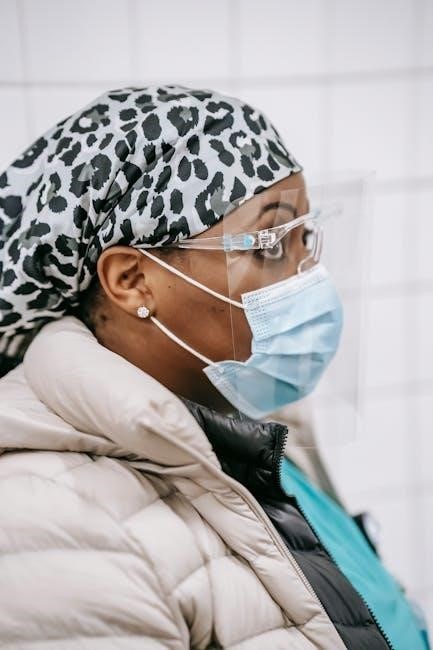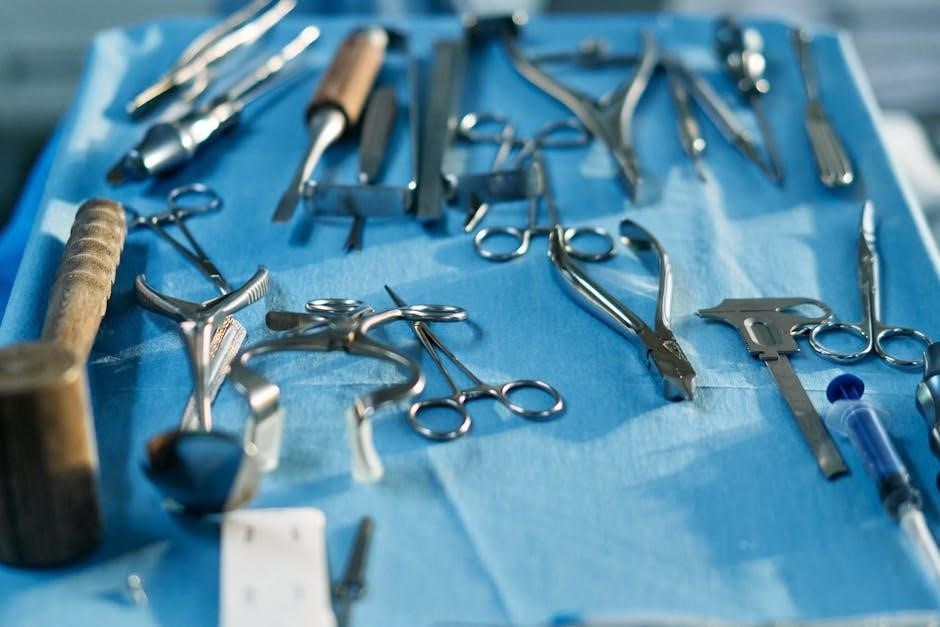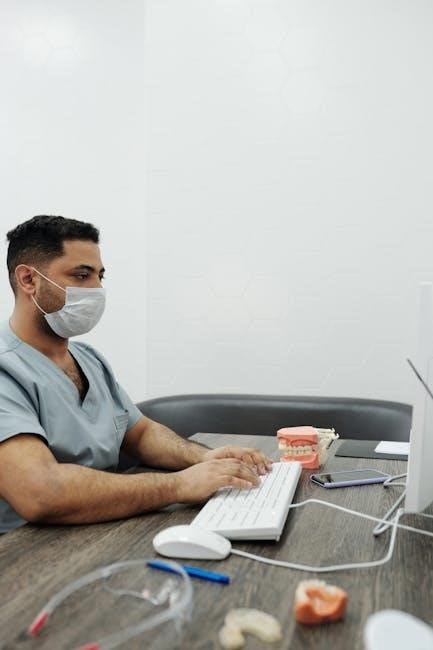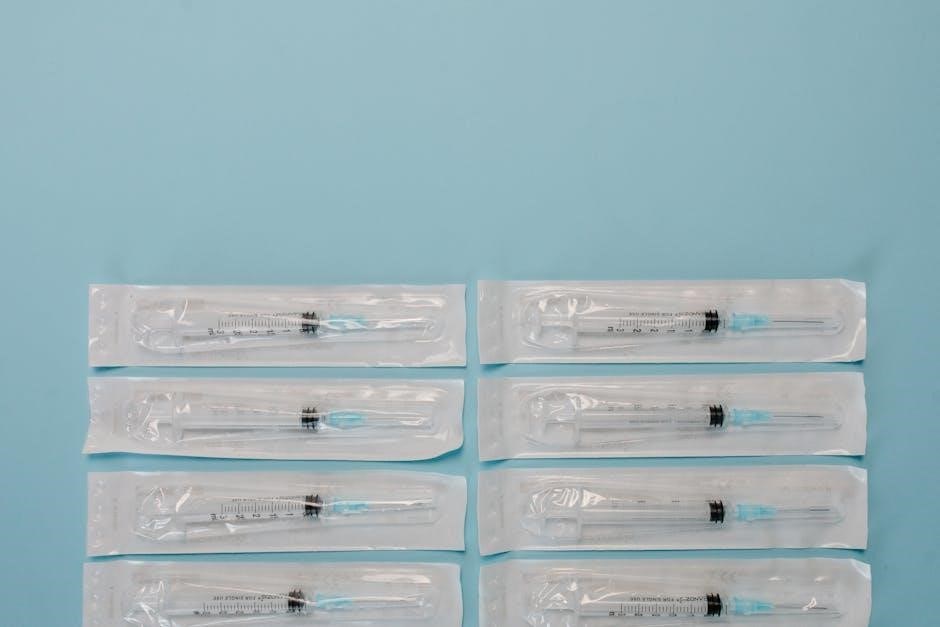Surgical sutures are medical tools used to close wounds or incisions, ensuring proper tissue healing. They are classified into absorbable and non-absorbable types, with varying materials like silk, catgut, Vicryl, and Monocryl. Sutures play a critical role in surgeries, from general soft tissue closure to specialized applications in ophthalmology and neurosurgery, making them indispensable in modern medicine.
1.1 Overview of Surgical Sutures
Surgical sutures are essential tools in medical procedures, used to close wounds or incisions by approximating tissues. Available in various materials, such as natural (silk, catgut) and synthetic (Vicryl, Monocryl), sutures cater to different surgical needs. They are categorized into absorbable and non-absorbable types, each designed for specific applications. Proper suture selection ensures effective wound closure, minimizing complications and promoting healing. Their versatility makes them indispensable in modern surgical practices.
1.2 Historical Development of Sutures
The use of sutures dates back to ancient civilizations, with evidence of suturing found in Egyptian mummies and early surgical practices. Initially, natural materials like plant fibers and animal sinew were used. The introduction of catgut, made from animal intestines, marked a significant advancement. Synthetic sutures, such as nylon and polyester, emerged in the mid-20th century, offering improved strength and predictability. Modern sutures now include absorbable options, reducing the need for removal and enhancing patient comfort.
Classification of Surgical Sutures
Surgical sutures are classified into absorbable and non-absorbable types, with further divisions into monofilament, multifilament, and barbed sutures. These classifications are based on material properties and structure.
2.1 Absorbable vs Non-Absorbable Sutures
Absorbable sutures, such as Vicryl and Monocryl, degrade naturally in the body, eliminating the need for removal. Non-absorbable sutures, like nylon or polyester, remain intact and require manual removal. The choice depends on the wound type, healing process, and surgical requirements, with absorbable sutures ideal for temporary support and non-absorbable for permanent closure.
2.2 Monofilament vs Multifilament vs Barbed Sutures
Monofilament sutures, made from a single strand, offer smooth passage through tissue, reducing friction and infection risk. Multifilament sutures, braided from multiple strands, provide greater strength and flexibility but may harbor bacteria. Barbed sutures feature tiny barbs that prevent slippage, ideal for tension-bearing areas. Each type balances strength, flexibility, and infection risk, catering to specific surgical needs and tissue requirements.

Types of Suture Materials
Surgical sutures are made from natural or synthetic materials, such as silk, catgut, Vicryl, and Monocryl. These materials vary in strength, durability, and compatibility with human tissue.
3.1 Natural Suture Materials (e.g., Silk, Catgut)
Natural suture materials, such as silk and catgut, are derived from biological sources. Silk is a non-absorbable suture made from silk fibers, known for its strength and ease of handling, but it can cause an inflammatory response. Catgut, an absorbable suture made from animal intestines, is less commonly used today due to its higher risk of infection and tissue reaction compared to synthetic alternatives.
3.2 Synthetic Suture Materials (e.g., Vicryl, Monocryl)
Synthetic sutures like Vicryl and Monocryl are widely used for their consistency and predictable performance. Vicryl, a braided suture, is absorbable and ideal for soft tissue closure, while Monocryl, a monofilament, is known for its smooth passage through tissue and minimal inflammation. Both materials are absorbed by hydrolysis, offering strong wound support during healing and eliminating the need for removal.

Coated vs Uncoated Sutures
Coated sutures reduce tissue friction and improve passage, while uncoated sutures are simpler but may cause more tissue drag. Coatings minimize irritation and infection risks.
4.1 Purpose of Suture Coatings
The primary purpose of suture coatings is to reduce friction during insertion, minimizing tissue damage and irritation. Coatings can also enhance biocompatibility, reduce bacterial adherence, and improve handling. They may incorporate antimicrobial agents to lower infection risks, making coated sutures particularly beneficial in sensitive or high-risk surgical procedures.
4.2 Benefits and Drawbacks of Coated Sutures
Coated sutures offer enhanced ease of use, reduced tissue irritation, and lower infection risks due to antimicrobial properties. However, they may be more expensive and prone to coating material reactions. Additionally, coatings can wear off during prolonged surgeries, potentially reducing their effectiveness in complex or long-duration procedures;
Absorbable Sutures
Absorbable sutures provide temporary wound support and are absorbed by the body over time, eliminating the need for removal. They are ideal for internal or temporary closures.
5.1 Characteristics of Absorbable Sutures
Absorbable sutures are designed to provide temporary wound support and degrade naturally in the body over time. They are typically made from synthetic materials like Vicryl or Monocryl, which are absorbed through hydrolysis. These sutures are ideal for internal use, eliminating the need for removal. Their absorption rate varies, ranging from weeks to months, depending on the material and surgical application.
5.2 Common Types of Absorbable Sutures
Absorbable sutures include Vicryl, Monocryl, catgut, and PDS. Vicryl is a braided suture with excellent knot security, often used in general soft tissue closure. Monocryl is monofilament, providing smooth passage through tissue and minimal irritation. Catgut is a traditional natural suture, while PDS offers extended absorption and is ideal for surgeries requiring prolonged wound support. Each type has distinct absorption rates and applications.

Non-Absorbable Sutures
Non-absorbable sutures provide permanent wound support, requiring manual removal. Common types include Nylon, Polyester, and Stainless Steel, used in skin closure, orthopedic surgeries, and cardiovascular procedures, offering durability and resistance to infection.
6.1 Characteristics of Non-Absorbable Sutures
Non-absorbable sutures are permanent, requiring manual removal, and are made from materials like Nylon, Polyester, and Stainless Steel. They offer high tensile strength, resistance to pathogens, and minimal tissue reaction. These sutures are ideal for external wounds, skin closure, and high-stress areas, providing long-term support without degrading over time, making them durable and reliable for extended healing processes.
6.2 Common Types of Non-Absorbable Sutures
Common non-absorbable sutures include Nylon, Polyester, and Stainless Steel. Nylon is flexible and often used for skin closure. Polyester is strong and used in cardiovascular surgeries. Polypropylene (Prolene) is inert and commonly used for general soft tissue and abdominal closures. Stainless Steel sutures are used in high-stress areas like orthopedic procedures, offering exceptional durability and strength.
Surgical Suture Techniques
Surgical suture techniques involve precise methods to close wounds, including interrupted, continuous, and subcuticular stitches. Proper handling of needles and threads ensures effective tissue approximation and healing.
7.1 Interrupted vs Continuous Suture Techniques
Interrupted sutures involve placing individual stitches, allowing precise tissue approximation and easy removal. Continuous sutures use a single strand, offering faster closure and even tension. Interrupted sutures are ideal for layered closures and cosmetic-sensitive areas, while continuous sutures are preferred for simple, linear wounds, such as skin or fascia closure, ensuring efficient healing with minimal tissue trauma.
7.2 Subcuticular and Retention Sutures
Subcuticular sutures are placed under the skin to close the dermal layer, minimizing visible scarring. They are often absorbable and used in cosmetic procedures. Retention sutures, however, are placed through multiple tissue layers to reinforce wounds under high tension, such as abdominal closures. These sutures prevent wound dehiscence and are typically non-absorbable, providing strong support during the healing process.
Factors Influencing Suture Selection
Surgeons consider anatomical location, wound type, and tissue stress when selecting sutures. Suture strength, absorption rate, and material compatibility also play crucial roles in ensuring optimal healing outcomes.
8.1 Anatomical Location and Wound Type
The anatomical location and wound type significantly influence suture selection. For instance, skin sutures differ from those used in fascia or muscle. Wound depth, tissue fragility, and infection risk also guide choices. Absorbable sutures are preferred for internal tissues, while non-absorbable sutures are ideal for skin closure. The suture material must match the healing requirements of the specific anatomical site to ensure optimal wound closure and minimize complications.
8.2 Tissue Stress and Suture Strength
Tissue stress and suture strength are critical factors in suture selection. High-stress areas, such as the abdomen or muscles, require strong sutures to withstand tension. Suture strength must align with tissue healing rates, as excessive strength can cause irritation, while insufficient strength may lead to wound separation. The balance ensures proper wound support without compromising tissue integrity or delaying healing.
Applications of Surgical Sutures
Surgical sutures are widely used in general surgery, soft tissue closure, and specialized procedures like ophthalmology and neurosurgery. They are essential for skin closure, hernia repair, and lacerations.
9.1 General Surgery and Soft Tissue Closure
Surgical sutures are extensively used in general surgery for closing skin, fascia, and soft tissue. Absorbable sutures like Vicryl and Monocryl are preferred for internal tissues, while non-absorbable sutures such as nylon are used for skin closure. They are essential in abdominal surgeries, lacerations, and hernia repairs, ensuring proper wound healing and minimizing scar formation. Synthetic materials are often chosen for their strength and minimal tissue reaction.
9.2 Specialized Applications (e.g., Ophthalmology, Neurosurgery)
Surgical sutures play a critical role in specialized surgeries like ophthalmology and neurosurgery, where precision is paramount. In ophthalmology, fine sutures are used for corneal repairs or cataract surgeries to minimize scarring. In neurosurgery, non-absorbable sutures are often preferred for their durability and minimal tissue reaction, ensuring secure closure in delicate brain or spinal cord procedures. These applications highlight the importance of suture material selection for optimal outcomes.

Benefits and Risks of Surgical Sutures
Modern sutures offer strong wound closure and minimize scarring, but risks include infection, allergic reactions, and tissue damage. Proper selection and technique are crucial for optimal outcomes.
10.1 Advantages of Modern Suture Materials
Modern suture materials offer enhanced strength, predictability, and biocompatibility, reducing complications. Synthetic sutures like Vicryl and Monocryl provide consistent absorption rates, minimizing scar tissue. Antimicrobial coatings further reduce infection risks, while monofilament designs minimize tissue irritation. These advancements improve healing outcomes and patient safety, making them indispensable in contemporary surgical practices.
10.2 Potential Complications and Risks
Surgical sutures can lead to infections, allergic reactions, or tissue strangulation if tied too tightly. Improper handling may cause material damage, and certain coatings, like triclosan, have debated benefits. Suture selection must balance factors like tissue stress and patient allergies to minimize risks, ensuring optimal wound healing and patient safety. Proper technique is critical to avoid complications.
Surgical sutures are essential for effective wound closure, balancing strength, and tissue compatibility. Their evolution reflects advances in material science and technique, ensuring safer and more reliable outcomes.
11.1 Future Trends in Suture Technology
Future trends in suture technology focus on advanced materials like antimicrobial coatings and biodegradable polymers. Researchers are developing sutures with drug-delivery capabilities to enhance healing and reduce infection risks. Additionally, barbed sutures are gaining traction for minimizing tissue trauma and improving closure efficiency. These innovations aim to optimize surgical outcomes, reduce recovery times, and address specific patient needs more effectively.
11.2 Importance of Proper Suture Selection
Proper suture selection is critical for optimal surgical outcomes, minimizing complications, and promoting wound healing. Surgeons consider factors like wound type, anatomical location, and tissue stress when choosing between absorbable or non-absorbable sutures. Correct selection ensures adequate tissue support, reduces infection risks, and avoids unnecessary scarring. It also addresses patient-specific needs, such as allergies or sensitivity to certain materials, enhancing overall recovery and patient satisfaction.